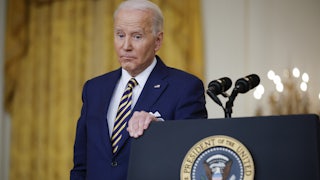In recognition of hitting his one-year anniversary as president, Joe Biden held a wide-ranging (maybe too wide-ranging) press conference Wednesday afternoon where he argued his administration had accomplished a lot (with of course more left to do) and that he had turned the country in the right direction.
Oddly, the president only modestly highlighted what is by far his most important and historic accomplishment: the roughly $1 trillion bipartisan infrastructure bill the Biden team moved into law last November. Biden alluded to his infrastructure bill when pressed about what he’s been able to get done during his first year in office. “I’ve got two real big ones done, bigger than any president has ever gotten in the first term,” Biden said.
It was an odd near-omission, especially since outside the press conference, the infrastructure law has been the main focus of the Biden administration over the last few days. All week, the White House and its allies in Congress have been promoting the Biden administration’s implementation of the infrastructure bill, which the president signed into law last November. The White House has been posting fact sheets online. The Democratic National Committee has been sending out extended lists of local press coverage about how the infrastructure money is being distributed. Mid-morning on Thursday, Biden and Vice President Harris are scheduled to meet with the administration’s Infrastructure Task Force. The task force is co-chaired by Brian Deese, director of the National Economic Council, and Keith Hennessey, the assistant to the president for economic policy, and includes various Cabinet and subcabinet officials.
The Biden administration’s intentions are clear: fight Democratic voters’ malaise and reasonable sense of doom by pointing to something the president has done. But even in the hyping up, the rub is pretty easy to find, even in the clips the Biden team wants you to read. The allocated funding to fix the country’s crumbling infrastructure happens over multiple years rather than a few months. So even in states with some of the most deficient bridges in the country (like Iowa and Pennsylvania), the funding allocated through the law doesn’t become available all at once. That’s despite the fact that the aforementioned states are getting $5 billion and $1.6 billion respectively as part of the law’s more than $27 billion for bridges over the next five years.
“The big signature legislative pieces that are more immediate near-term are in Build Back Better,” Democratic pollster Ben Tulchin, who has conducted polling on infrastructure, said. Tulchin stressed that the infrastructure law and Biden’s Build Back Better social spending bill, which remains stalled in Congress, are both good, but getting more “bang for your buck politically [comes] from some element of” the Build Back Better bill. “The infrastructure bill is just not quite as immediate or broad based in terms of its appeal.”
That means, Tulchin continued, Democrats “have to tell a story to voters in the campaigns this summer, this fall. It didn’t quite get the pop from the outset, so they have to tell the story.”
That’s what Democrats are frantically trying to do now.
On Tuesday, former New Orleans Mayor Mitch Landrieu, the Biden administration’s infrastructure czar, offered an overview of the work he’s been doing at the daily White House press briefing. Landrieu, once a very visible Democratic figure who made a national name for himself with his poignant defense of removing Confederate statues in his deep-South city and even toyed with running for president, has reemerged into the public spotlight since taking the infrastructure czar job.
At the press conference, Landrieu acknowledged the reality that all this may take a while. “This infrastructure work in general is not a one-time economic stimulus. It is not a race to see how many ribbons we can cut before the end of the year. Doing this is going to require balance, it’s going to require order,” he said. “We are definitely going to go fast, but we are not going to hurry and we are going to get it right.”
In an interview with The Wall Street Journal last week, Landrieu described his qualifications for the infrastructure job. The choice was an interesting one. The Journal’s readership base consists of corporate Republicans and business types, but Democrats often use the Journal to grab the attention of business-world Republicans and C-suite types. This rare interview was just that—and another indicator that the Biden administration wanted to move the press’s focus away from its increasingly quixotic quests for filibuster reform and the Biden administration’s more expansive social spending package. It’s clear those initiatives are increasingly going nowhere without some kind of dramatic course correction or external event.
Landrieu, at the Tuesday press conference at the White House, said he had talked with nearly all 50 governors and a plethora of mayors. He didn’t elaborate on what those conversations entailed. Multiple interviews with officials at mayoral offices, Senate offices, and governor’s mansions revealed a broader effort by the Biden administration to work with them to implement the infrastructure proposals. That’s in part because, according to one Democratic governor’s aide interviewed for this story, during the first few months of the Biden administration, governors across the country were frustrated with how difficult it was to contact or work with this White House. This is a clear move to improve that sentiment, the aide said.
Landrieu has been encouraging
governors to get their own statewide infrastructure czar or put in place their
own team to implement the money allocated to those states through the law, according
to another governor’s aide. Landrieu and his team have also been reaching out
to mayors and encouraging them to “break down silos” between the federal
government and statewide and municipal authorities as well, another mayor who
requested anonymity to describe the private conversations recounted to The New
Republic.
Landrieu pointed to all of that Tuesday during his press conference. He and the Biden administration wanted to drill home the point that this administration will actually improve the country’s infrastructure in a bipartisan fashion. “Let me tell you now, every week is going to be infrastructure week, except we’re going to actually build stuff,” Landrieu said.
One little fact that illustrates the lengths the administration is going in order to get the word out: Other Biden administration officials, like Commerce Secretary Gina Raimondo and Acting Office of Management and Budget Director Shalanda D. Young, have been in touch with senators about the infrastructure bill, underscoring the administration’s interest in making sure everyone has something positive to say about the law. Even behind the scenes, the Biden administration wants every lawmaker it can reach to be able to tout the benefits of the infrastructure bill or at least feel like they have a stake in its success. Other aides have been talking on the phone with House lawmakers on the benefits of the law.
The Biden administration wants Americans to know it’s spending big on infrastructure. A fact sheet released on Friday lists various allocations of the funding provided in the infrastructure law: $27 billion for repairing and rehabilitating bridges; $7.5 billion to upgrade the country’s “aging water infrastructure”; $20 billion to “scale up clean energy, create new, good-paying jobs for American families and workers, and reduce pollution while benefiting underserved communities.” Similarly on Tuesday, the Democratic National Committee released a long list of investments for bridges around the country under the law in the near future: Alabama’s getting $225 million for its bridges that need repair, Maine is getting $225 million, Nevada will receive $45 million, Oklahoma is getting $267 million, and so on.
There’s an incentive for Democrats to highlight the infrastructure law. But standing in front of a deteriorating bridge and saying that it will be repaired in the near future doesn’t have quite the same oomph as the traditional ribbon-cutting ceremony, where a grinning lawmaker takes credit for a brand-new public work. In Illinois, Democratic lawmakers gathered and held a press conference on the Rand Road Bridge that goes over the Des Plaines River, which the Chicago Tribune describes as being in “poor condition.” It’s one of 240 bridges in Cook County with that rating by the Federal Highway Administration.
This entire episode is a reminder that the country’s infrastructure has aged. In Tucson, Arizona, the Interstate 10 bridge over Ajo Way is one bridge slated for improvement under the law. It was built in 1965.
What’s clear is that Biden and his team want to focus on something abstractly and actually popular (a bipartisan infrastructure bill) to try and counter or eliminate completely the idea that the Biden administration hasn’t accomplished much.
“There’s been a ton of public polling that all the individual aspects of the infrastructure bill and the package are really popular,” John Anzalone, a Democratic pollster who has done work for Biden, said. “This is a big issue all across the country, regardless of region.”
The place the Biden administration finds itself in might feel similar to the earliest months of the Obama administration, when it was frantically working to push its infrastructure-focused stimulus bill to try and heal a hemorrhaged American economy. But Austan Goolsbee, a former top economist for the Obama administration, stressed that the situation is somewhat different.
“The goal of this infrastructure package is excessively about the infrastructure,” Goolsbee said in an interview on Tuesday. He contrasted that to the Obama administration’s early stimulus package, “where the goal of that was to get money out the door as quickly as possible. That was the purpose. The challenge in a thing like that is, ‘What’s the fastest, what can be done right away?’ that’s taking place with a certain type of backdrop of economic chaos from the financial crisis and the extended recession. That’s very different from the one we’re in now.”
The timing of this public and private push may be coincidental. Anzalone stressed that efforts like highlighting the impact of a massive law like this infrastructure package doesn’t happen when a White House gets nervous about lackluster poll numbers. But it sure looks like this White House is doing that. Either way, an ominous midterm election is less than a year away, and officials know they need some kind of accomplishment to point to.








